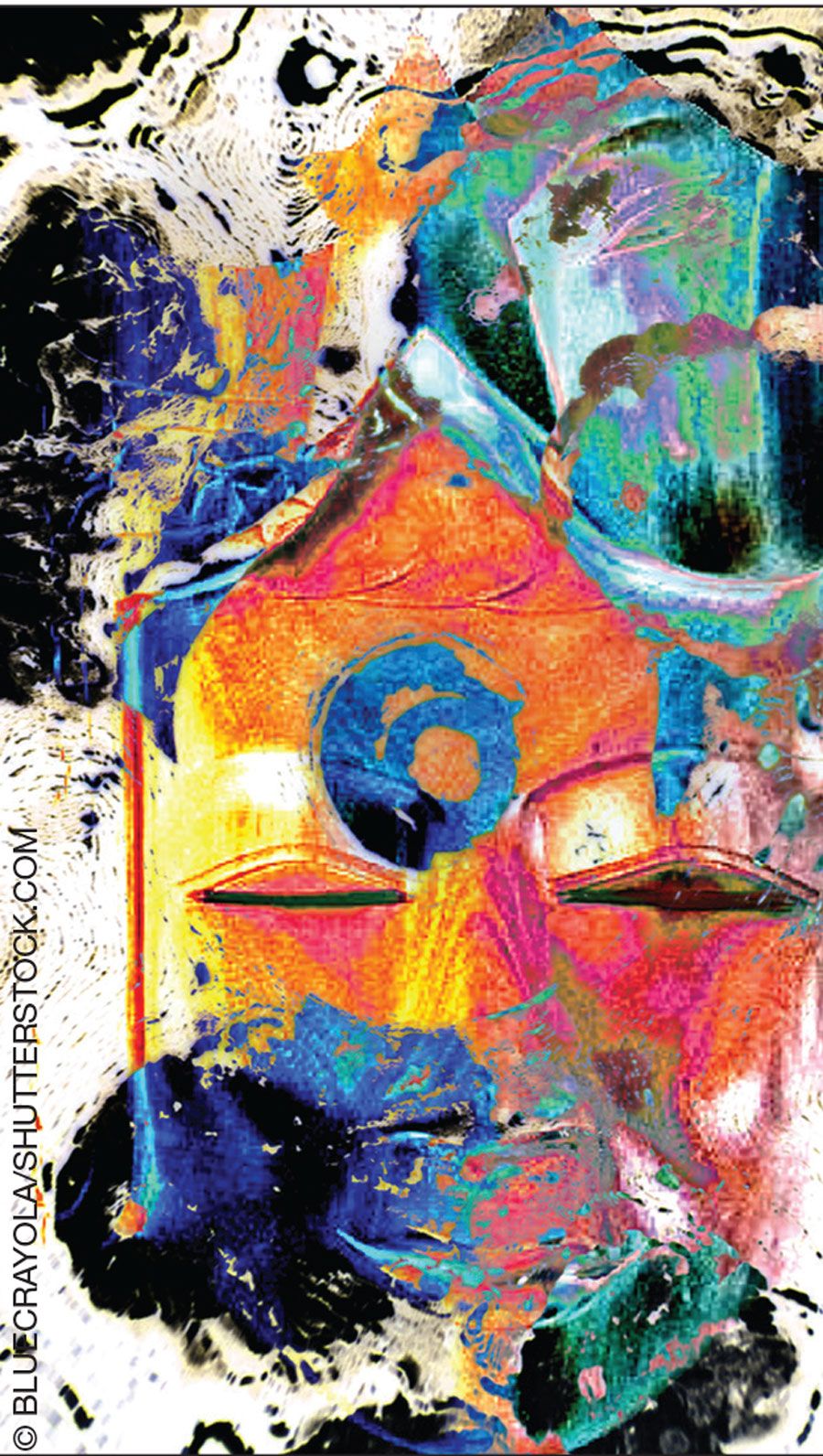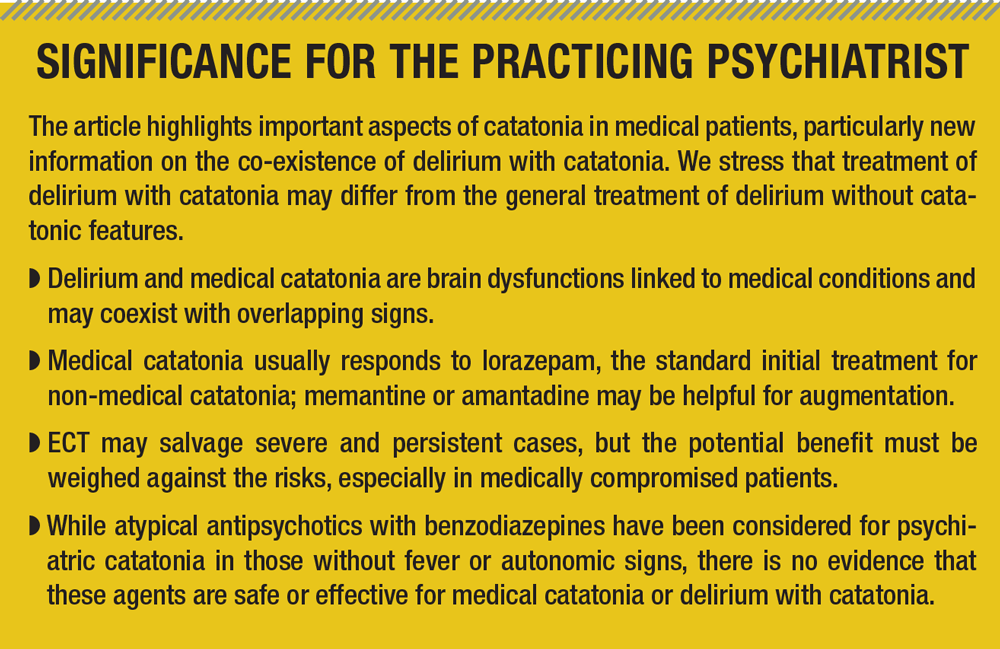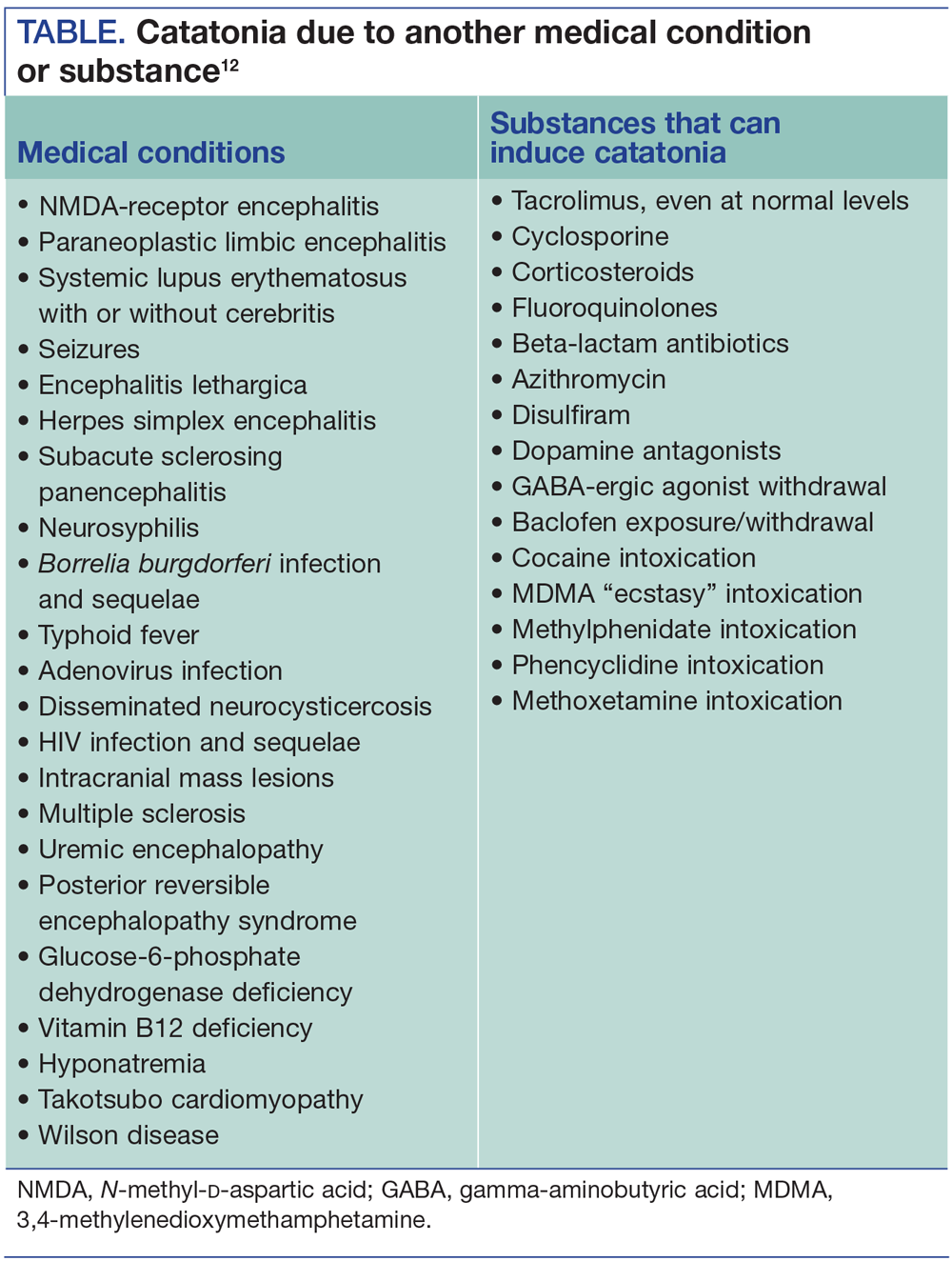Publication
Article
Psychiatric Times
Update on Medical Catatonia: Highlight on Delirium
Author(s):
Renewed interest and emerging systematic data have highlighted the frequency and pattern of catatonic presentations in psychiatric and medical settings, including in critical illness.
© BLUECRAYOLA/ SHUTTERSTOCK.COM

SIGNIFICANCE FOR THE PRACTICING PSYCHIATRIST

TABLE.

Catatonia, described in 1874 by K. L. Kahlbaum, is a distinct and heterogeneous neuropsychiatric syndrome, with both motoric and behavioral signs. It may be hypokinetic, hyperkinetic, or mixed and includes volitional signs, such as mutism, negativism, and automatic obedience. It was formerly relegated to a schizophrenia subtype, or considered extinct after the advent of modern psychopharmacology. Renewed interest and emerging systematic data have highlighted the frequency and pattern of catatonic presentations in psychiatric and medical settings, including in critical illness.
Assessment
Historically, up to 40 signs were recognized, and most are now included in the published scales for detecting and rating the severity of catatonia. The Bush-Francis Catatonia Rating Scale (BFCRS) is widely used in both clinical and research settings, shows high inter-rater reliability and favorable sensitivity and specificity, and was validated in a mixed medical and psychiatric sample.1 The 23-item BFCRS was derived from classic descriptions of catatonia and modern diagnostic criteria. Cases are defined by the presence of 2 or more of the first 14 signs.
DSM-5 criteria require 3 or more from a similar list of 12 common catatonic signs. The BFCRS or DSM-5 items identify diverse clinical features, including motoric, behavioral, volitional, and autonomic signs. Statistical analyses identified subtypes of catatonia, including a retarded and an excited form. Malignant catatonia-a severe form with fever and autonomic instability-is uncommon but is important to identify as it may be fatal if not recognized and aggressively treated.
Despite effective treatments, patients with any form of catatonia remain at risk from serious complications such as dehydration, muscle breakdown, aspiration, or embolic phenomena. Once catatonia is recognized, these risks can be mitigated by effective treatments. Among the most studied treatment modalities, regardless of the underling etiology, prompt administration of gamma-aminobutyric acid (GABA) receptor agonists or ECT for severe or resistant cases usually relieves the symptoms and may be lifesaving.
Pathology of catatonia in the context of medical illness
The exact pathogenesis of catatonia remains unknown. Systematic examination of catatonia with genetic and brain imaging studies has been slow to develop. Familial aggregation has been reported for periodic catatonia, and preliminary evidence associated this with 15q15 chromosome.2 Single photon emission CT studies using a GABA-A ligand revealed reduced binding in areas of the frontal lobe.3 More recent studies showed increased cerebral blood flow in the supplementary motor cortex, which correlated with BFCRS severity scores, and apparent loss of frontal and insular gray matter in catatonic schizophrenia.4
Related content.
Mini Quiz: Medical Catatonia
For catatonia in medical populations, the pattern or frequency of catatonic signs does not distinguish psychiatric from medical catatonia. A review of case reports on catatonia associated with brain lesions found an association with frontal and basal ganglia damage. The most recent systematic reports of medical catatonia confirm that non-localizing encephalopathies were the most common primary diagnoses associated with catatonia; a variety of non-specific EEG findings were also seen.5,6 Catatonia is generally thought to be under-recognized in the medically ill.
Catatonia and delirium
Of particular interest and potentially of great clinical significance is the relationship between catatonia and delirium. Delirium is the classic syndrome of acute brain dysfunction-with disturbed attention, awareness, and cognition-and is predictive of excess mortality, longer hospitalization, costlier care, and long-term cognitive impairment. While delirium is often assessed in critical settings such as the ICU, catatonia is not. Recognition and study of ICU catatonia have until recently been hindered by recent editions of DSM, which consistently hold that catatonia cannot be diagnosed in the presence of delirium. However, there is no clear evidence to support the exclusion.
Despite the DSM exclusion, delirium might coexist with catatonia, perhaps most prominently in the hypoactive motoric subtype of delirium. Hypoactive delirium includes decreased motor activity, decreased speech, and behavioral withdrawal-all of which map to catatonic features.
The first prospective report of catatonia with delirium was published in 2014.7 The data showed that 13% of 205 consecutive delirium cases met DSM-5 criteria for catatonia, and 32% met BFCRS criteria for catatonia. However, no treatment or outcome data were presented.
The many implications of more clinical attention and systematic study of comorbid delirium and catatonia include prognosis and management. For catatonia, active treatment consists of benzodiazepines (typically lorazepam) and/or ECT; antipsychotics are generally avoided because they may worsen catatonia or precipitate a lethal or malignant form similar to neuroleptic malignant syndrome (NMS). Conversely, treatment of delirium addresses the underlying medical condition and environmental factors, and antipsychotics are often used; however, benzodiazepines are generally avoided (except for known substance-withdrawal delirium).
There are no prospective data on the management or outcome of catatonia with delirium that address this apparent dilemma. However, a recent study of medical inpatients identified 54 cases of catatonia of whom 43% had a prior psychiatric history, while 54% had suspected delirium.6 When medical catatonia was compared to that attributed to psychiatric disorders, there was no statistical difference in the rates of treatment attempts using lorazepam nor in response, which was greater than 80%. However, cases of catatonia comorbid with suspected delirium were less likely to respond to lorazepam (71%) than cases without delirium (100%), regardless of etiology. While this was a retrospective study, it supports the assertion that catatonia and delirium can be comorbid and suggests that in many cases the treatment of catatonia with benzodiazepines may be successful in the presence of a delirium.
Differential diagnosis
A variety of medical conditions can produce stupor, which is a decreased awareness and interaction with the external environment. Stupor can occur with preserved alertness, more often seen in catatonia, or with lethargy, more often seen in delirium. Stupor that is associated with a metabolic disorder or that is associated with delirium may present with catatonic features. The Table presents examples of medical conditions associated with catatonia.
NMS, serotonin syndrome, and non-convulsive status epilepticus are other examples of stuporous states associated with catatonia. It may be that NMS and serotonin syndrome are actually medication-induced malignant catatonia.
Delirious mania is a rare syndrome linked to bipolar disorder characterized by the rapid onset of delirium, mania, and psychosis, with prominent hyperactive catatonia. Delirious mania can be construed as a malignant hyperactive form of catatonia, as well as a hyperactive delirium. Delirious mania has been associated with medical disorders. The newly characterized excited delirium syndrome, induced by cocaine or other stimulants, has been likened to delirious mania. Delirious mania was reported after cerebellar/pontine stroke, which produced delirium that was treated with antipsychotics that led to a catatonic state; this ultimately resolved with continuation of valproate, removal of antipsychotics, and administration of lorazepam.8
Treatment strategies
Differences between etiologies (psychiatric vs medical) do not appear to alter the general treatment approach for catatonia. Removal of suspected offending agents, treatment of the underlying medical condition, or management of drug withdrawal are essential for both forms of catatonia.
For persistent catatonia, rapid initiation of lorazepam or a related benzodiazepine, which may require cautious titration to higher dosages (eg, 8 mg/d or more of lorazepam), usually leads to improvement of symptoms. Benzodiazepines (and related agents such as amobarbital and zolpidem) may counteract hypothesized GABA-receptor hypofunction in catatonia. Intravenous lorazepam has more assured absorption and may exert more prolonged clinical effects than the oral form based on differing drug distribution.
Potential adverse effects of high-dose intravenous lorazepam include anion gap acidosis from its solvent, propylene glycol. This risk increases with higher doses and in renal impairment, but toxicity has been reported with as little as 2 mg per hour. The osmolar gap (a marker for glycol toxicity) should be monitored every other day if the lorazepam infusion reaches 1 mg/kg daily.
Augmentation with memantine or amantadine may also be helpful. Their hypothesized mechanism is N-methyl-d-aspartic acid (NMDA) receptor antagonism, which may be linked to GABA hypofunction. Memantine can be started at 5 to 10 mg daily and titrated based on medical status with monitoring of the QT interval. Improvement from memantine seems slower than with lorazepam, but both can be co-administered. Amantadine is started at 100 to 200 mg daily and titrated, but it should be used with caution if renal impairment or seizure risk is present. Mania, suicidal ideation, and withdrawal-emergent NMS have also been reported with administration of amantadine.
ECT can be considered for inadequate medication response for persistent and severe catatonia and may be used more emergently for malignant features (autonomic instability and hyperthermia). Use of ECT for catatonia in medical settings or with uncertain CNS pathology should be approached cautiously, and the potential benefit weighed against the known adverse risk of severe and prolonged catatonia. Some reports show a benefit of ECT for catatonia for various acute neurological illnesses.9 However, no benefit was seen with the use of ECT in catatonia after cerebral hypoxia; in this setting, it may worsen neurological status.10
Atypical antipsychotics were reported to benefit some cases of non-medical catatonia after other treatments had failed, or for coexistent catatonia and psychosis when ECT was not feasible.11 Serum iron should be measured, since low levels may be predictive of conversion to malignant catatonia. Benzodiazepines should be continued concurrently with the antipsychotic, with monitoring for extrapyramidal or autonomic symptoms that portend malignant catatonia or NMS. Antipsychotics in medical catatonia or delirium with catatonia have not been studied, and caution is advised with their use.
Collaboration with medical services
When medical catatonia is identified, the primary hospital service may initially resist lorazepam treatment, particularly when the patient is medically compromised. Under-dosing of lorazepam and treatment failure may result if the rationale for its use is not clearly expanded. Inviting the primary care team to witness a lorazepam or zolpidem challenge may help medical specialists appreciate that a sedating agent can improve catatonic stupor.
Frequent vital sign assessments, monitoring of the osmolar gap, and pulse oximetry can improve safety, along with ready access to flumazenil for reversal of potential adverse effects of benzodiazepines. If sedation is a concern, adding non-sedating memantine or amantadine may allow for lower benzodiazepine dosing.
When multiple hospital consultants are involved in complex cases, interdisciplinary meetings are strongly recommended. In such situations, we encourage a clear consensus that identifies specific targets for defining both treatment response and adverse effects.
Disclosures:
Dr. Wilson is Instructor in the Department of Psychiatry and Behavioral Sciences at Vanderbilt University Medical Center, Nashville, TN. Dr. Denysenko is Assistant Professor in the Department of Psychiatry at Rowan University School of Osteopathic Medicine, Cherry Hill, NJ. Dr. Francis is Professor of Psychiatry at Penn State Medical School, Hershey, PA.The authors report no conflicts of interest concerning the subject matter of this article.
References:
1. Bush G, Fink M, Petrides G, et al. Catatonia. I: rating scale and standardized examination. Acta Psychiatr Scand. 1996;93:129-136.
2. Stöber G, Saar K, Rüschendorf F, et al. Splitting schizophrenia: periodic catatonia: susceptibility locus on chromosome 15q15. Am J Hum Genet. 2000;67:1201-1207.
3. Northoff G, Steinke R, Czervenka C, et al. Decreased density of GABA-A receptors in the left sensorimotor cortex in akinetic catatonia: investigation of in vivo benzodiazepine receptor binding. J Neurol Neurosurg Psychiatry. 1999;67:445-450.
4. Walther S, Schäppi L, Federspiel A, et al. Resting-state hyperperfusion of the supplementary motor area in catatonia. Schizophr Bull. October 11, 2016; Epub ahead of print.
5. Smith JH, Smith VD, Philbrick KL, Kumar N. Catatonic disorder due to a general medical or psychiatric condition. J Neuro Clin Neurosci. 2012;24:198-207.
6. Llesuy JR, Coffey MJ, Jacobson KC, Cooper JJ. Suspected delirium predicts the thoroughness of catatonia evaluation. J Neuro Clin Neurosci. November 30, 2016; Epub ahead of print.
7. Grover S, Ghosh A, Ghormode D. Do patients with delirium have catatonic features? An exploratory study. Psychiatr Clin Neurosci. 2014;68:644-651.
8. Bobo WV, Murphy MJ, Heckers SH. Recurring episodes of Bell’s mania after cerebrovascular accident. Psychosomatics. 2009;50:285-288.
9. Rasmussen KG, Hart DA, Lineberry TW. ECT in patients with psychopathology related to acute neurologic illness. Psychosomatics. 2008;49:67-72.
10. Quinn DK, Abbott CC. Catatonia after cerebral hypoxia: do the usual treatments apply? Psychosomatics. 2014;55:525-535.
11. Sienaert P, Dhossche DM, Vancampfort D, et al. A clinical review of the treatment of catatonia. Front Psychiatry. 2014;5:181-185.
12. Denysenko L, Freudenreich O, Philbrick K, et al. Catatonia in Medically Ill Patients: An APM-EAPM Clinical Monograph. April 2015. http://www.apm.org/library/monographs/catatonia/Catatonia_APM-EAPM_2015-04-17.pdf. Accessed January 25, 2017.






